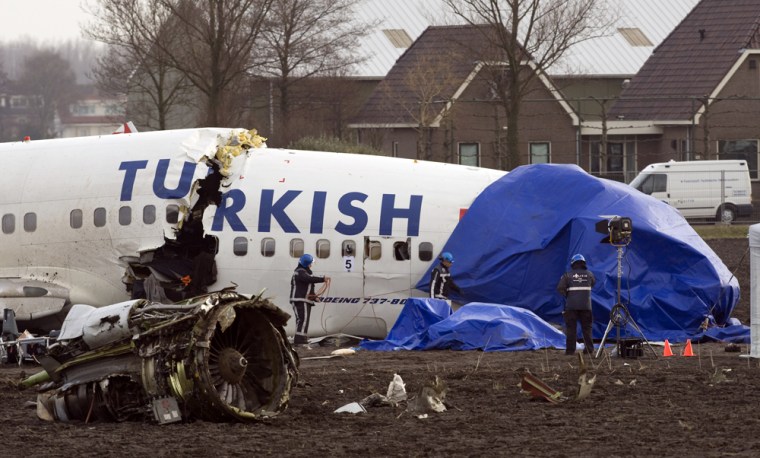The bodies of nine people killed in the crash of a Turkish Airlines flight in the Netherlands have been formally identified, a Dutch mayor said Friday, and The Boeing Co. said three of the four Americans among the dead were its employees.
Mayor Theo Weterings of Haarlemmermeer said the five Turkish victims would be taken home as soon as further formalities and paperwork allowed, while the U.S. Consulate was still deciding when to transport the bodies of the four Americans killed.
Of 135 people on the Boeing 737-800 that shattered into three pieces in a field shortly before it was due to land Wednesday morning, 63 remained hospitalized, one in critical condition, Weterings said.
The plane's flight data and cockpit voice recordings were being analyzed in Paris. Sandra Groenendal, spokeswoman for the Dutch Safety Authority, said a first assessment of what went wrong according to the black box data would likely be released by Wednesday.
Turkish Airlines said the dead included pilots Hasan Tahsin Arisan, Olgay Ozgur and Murat Sezer and flight attendant Ulvi Murat Eskin.
Boeing identified its workers who were killed as Ronald A. Richey of Duvall, Wash.; John Salman of Kent, Wash., and Ricky E. Wilson of Clinton, Wash. It said a fourth employee, Michael T. Hemmer of Federal Way, Wash., was hospitalized.
Authorities did not release the identity of the other American killed.
Boeing was flying the victims' relatives to the Netherlands if they wanted to come, spokesman Andrew Davis said, but he gave no details of their movements.
'Coming in at an odd angle'
Flight TK1951 was coming in from Istanbul when it crashed about one mile short of the runway at Amsterdam's Schiphol Airport.
One survivor, Henk Heijloo, said the last message he heard from the captain was for flight crew to take their seats. He said it took him a while to realize the landing had gone wrong.
"We were coming in at an odd angle, and I felt the pilot give the plane more gas," he said. He thought the pilot might have been trying to abort the landing, because the nose came up.
Pieter van Vollenhoven, head of the Dutch agency investigating the crash, said Thursday that the plane had fallen almost directly from the sky, which pointed toward its engines having stopped. He said a reason for that had not yet been established.
Groenendal said engine failure was still only "one of the possible scenarios" for the crash. Other possible causes range from weather-related factors to insufficient fuel, loss of fuel, navigational errors, pilot fatigue or bird strikes.
"(It) just fell straight down, and then you heard the engines at full power as if it was trying to go forward," survivor Fred Gimpel told the Dutch NOS news.
Witnesses: 300-foot fall
Witnesses on the ground said the plane dropped from about 300 feet.
Several crash survivors returned to Istanbul on Thursday — including Kerem Uzel, a student. He told Turkey's NTV television that he didn't realize anything was wrong until the plane was skidding through the muddy field.
Turkish Airlines chief Temel Kotil said Arisan, the plane's captain, was an experienced former air force pilot.
The airline also denied reports that the plane, which was built in 2002, had had technical problems in the days before the accident. The plane underwent routine maintenance Feb. 19, and had to delay a flight Feb. 23 — the day before the crash — to replace a faulty caution light.
